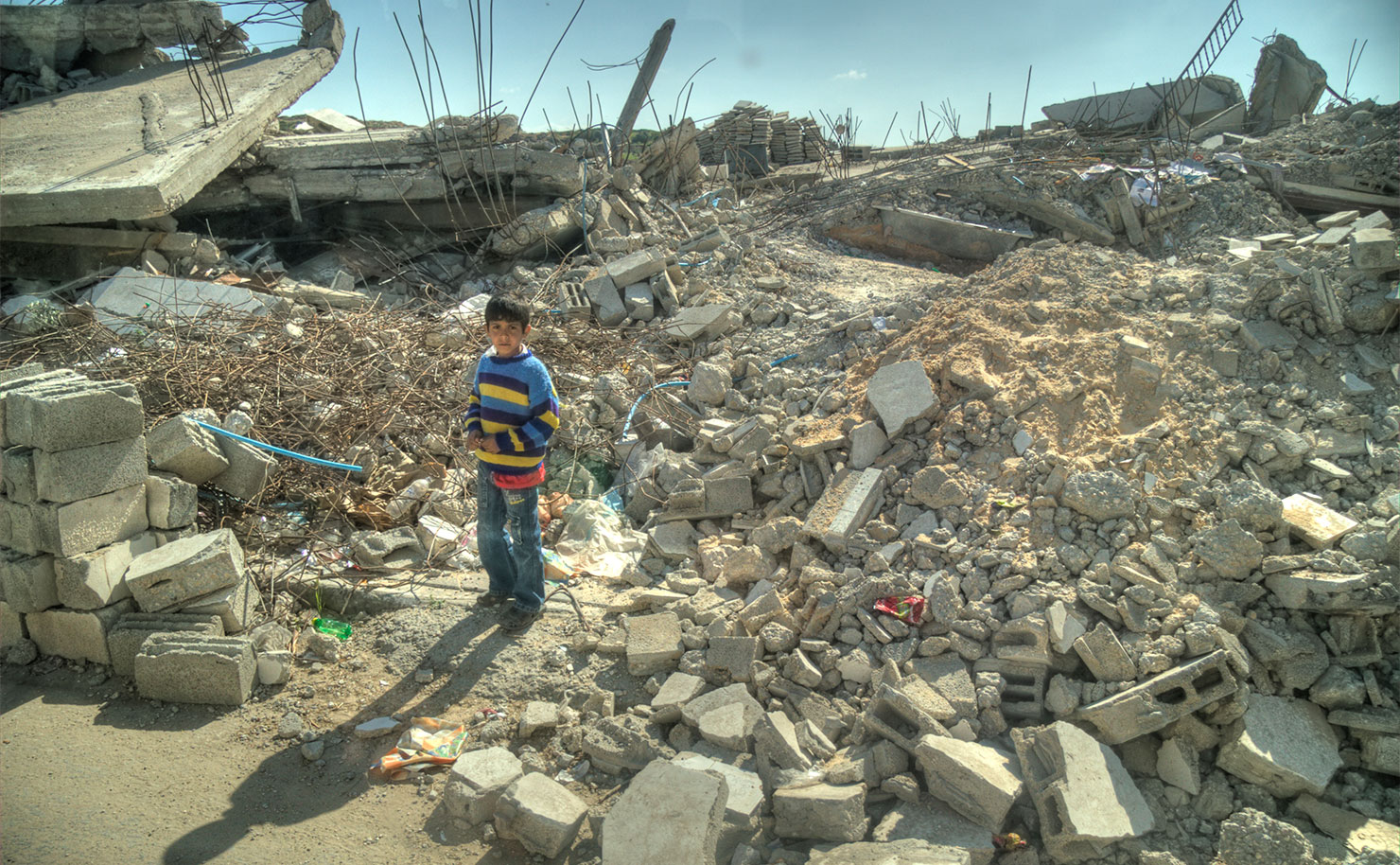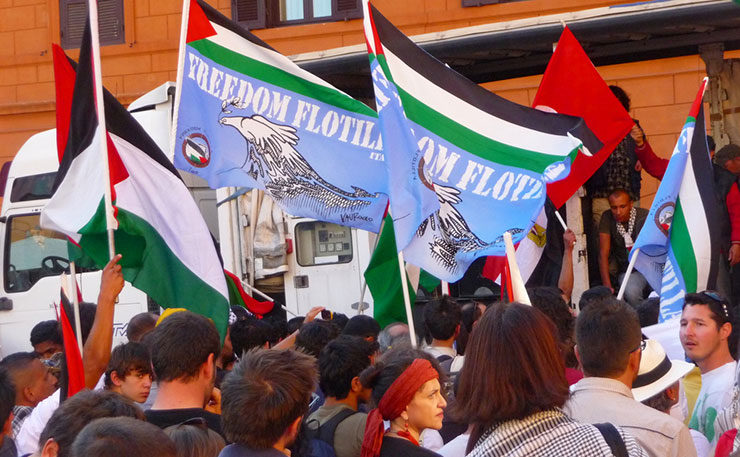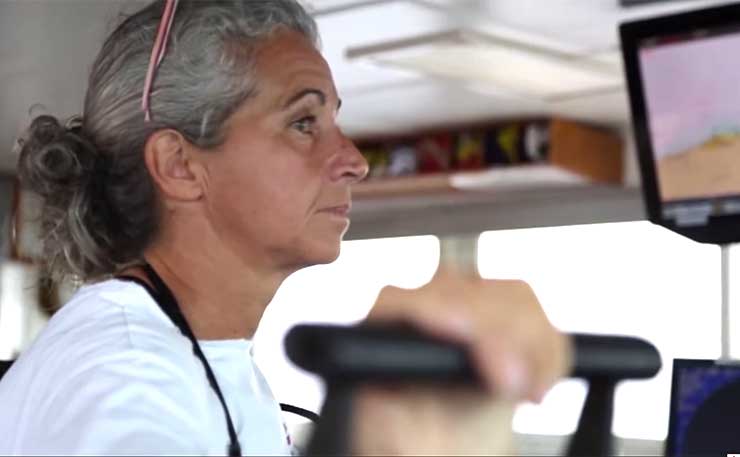An Australian woman travelled overseas to protest the slaughter of Gazans and break an illegal siege led by Israel. Meanwhile, nine young men, also from Australia, went to Malaysia and took their pants off at the Formula One. All got arrested, but one got substantially less media interest. Michael Brull explains.
On October 5, Israeli pirates hijacked a ship in international waters. There were 13 women aboard the ship, each from a different country. The boat, Zaytouna-Olivia, was captained by a woman from Hobart, Madeleine Habib.
After the boat was hijacked, the women were kidnapped by the Israeli army, and they were forcibly detained in Israel, before being deported. Habib arrived back in Australia on Saturday.
Another woman aboard the boat was Mairead Maguire. Maguire won the Nobel Peace Prize in 1976. In 2007, Israel’s army gained the dubious distinction of being the only official army in the world to have shot a Nobel Peace Prize Laureate*.
You can watch the video here. Maguire was attending a non-violent protest in Bi’ilin against the occupation of the West Bank, when soldiers threw tear gas at the protestors, and, from a safe distance, shot rubber coated steel bullets at the protestors.
One soldier shot Maguire in the back of the leg.
In an interview with Democracy Now, Maguire discussed the protest: “It was a totally nonviolent protest. And we were viciously attacked by the Israeli military. They threw gas canisters into the peace walkers, and they also fired rubber-covered steel bullets. As I tried to move back and helping a French lady, I was shot in the leg with a rubber-covered steel bullet, and the young Israeli soldier who shot me was only 20 meters from me. I was stunned by it, and then later on, after having some treatment by the ambulance medics, I went back down to the front line with the peace activists, and we were again showered with gas. I was overcome and had a severe nosebleed and had to be taken by stretcher to the ambulance and treated.”
Maguire was shocked. She said that there “were over 25 unarmed peace people who had been viciously attacked by the Israeli military. And it was a completely peaceful protest. It was absolutely unbelievable. I never in all my years of activism witnessed anything so vicious as from the Israeli military.”

That happened over nine years ago. Israel shot an unarmed Nobel Peace Prize Laureate at a non-violent protest, it was all filmed, and by now, it is so obscure that virtually no-one even knows it happened.
Now consider the siege on Gaza. In 2006, Israel imposed a siege on Gaza to punish the population for electing Hamas. In 2007, Israel’s security cabinet decided to identify Gaza as an enemy entity and tighten the siege, so as to allow for the cutting off of the supply of water, electricity and fuel to Gaza. They identified this as using “civilian levers” against Hamas.
In 2008, Israel told the US their goal was to keep Gaza’s economy “on the brink of collapse”. Israeli officials reportedly calculated the calories allowed into Gaza. The siege has been condemned as illegal by numerous NGOs, including Oxfam, Amnesty International, the Red Cross, Save the Children, and Christian Aid.
50 international charities and UN bodies, including the UN Children’s Fund (UNICEF), the World Health Organisation, and CARE International, issued a joint statement in 2012 calling the blockade illegal, and urging its immediate end.
In 2009, Amnesty pointed out the urgent need to lift the blockade, as 90-95 per cent of water in Gaza was not fit for drinking.
The Mavi Marmara
In 2010, brave activists, in the face of international apathy at Israeli lawlessness, decided to take matters into their own hands. They decided to sail into Gaza, to break the siege. If Israel let them through, it would show that goods could be brought to Gaza and the siege could be ended. After all, if there was no occupation of Gaza, as Israel claims, by what right could it patrol Gaza’s borders and prevent people from getting in?
On the other hand, if Israel did police Gaza’s borders, and prevent international visitors from getting into Gaza, then surely it would have to admit that it was occupying Gaza.
Those who subject a population to a military occupation are regarded as responsible for that population’s wellbeing. Thus, Israel could not besiege Gaza, and would have to allow in goods and allow exports out of Gaza.
Israel responded by hijacking one of the ships headed to Gaza, the Mavi Marmara, and killed nine people on board.

The UN Human Rights Council investigated these events. They concluded that a “humanitarian crisis” existed in Gaza. They observed that, “The preponderance of evidence from impeccable sources is too overwhelming to come to a contrary opinion. Any denial of this cannot be supported on any rational grounds. One of the consequences flowing from this is that for this reason alone the blockade is unlawful and cannot be sustained in law.”
From this conclusion, the Israeli army “intercepting the Mavi Marmara on the high seas in the circumstances and for the reasons given was clearly unlawful.”
The UN HRC observed that Israel has the right to protect itself, but “any action… which constitutes collective punishment of the civilian population in Gaza is not lawful in any circumstances”.
The report describes terrible brutality by the Israeli army. For example, two of those initially killed “received wounds compatible with being shot at close range while lying on the ground: Furkan Doğan received a bullet in the face”. İbrahim Bilgen’s wounds “are consistent with the deceased initially being shot from soldiers on board the helicopter above and receiving a further wound to the head while lying on the ground, already wounded.”
In the next phase, four more were killed when none “posed any threat to the Israeli forces”.
Once the activists had been kidnapped to Israel, they were subjected to severe brutality. For example, “a Greek national, was severely beaten for refusing to provide his fingerprints to the Israeli authorities. The passenger was dragged along the ground for some distance and then surrounded by a large group of Israeli officials who proceeded to beat him severely, including the deliberate fracture of his leg”.
The Mission expressed particular shock at “the consistent accounts of a number of incidents of extreme and unprovoked violence perpetrated by uniformed Israeli personnel upon certain passengers during the processing procedures inside the terminal at Ben Gurion International Airport on the day of deportation. These accounts were so consistent and vivid as to be beyond question.”
‘These accounts’ include several of group beatings by Israeli soldiers of flotilla passengers who had been kidnapped by Israel. For example, in one instance, Irish and Turkish passengers protested the rough way an old man was being treated. In response, they “were charged by soldiers using batons. In the foray, around 30 passengers were beaten to the ground, kicked and punched in a sustained attack by soldiers. One Irish passenger was seen being particularly badly beaten around the head and held in a choke position to the point of near suffocation”.
Uncooperative activists were subjected to particular cruelty. “One passenger was seen having his arm twisted behind his back by police to the point that the arm broke. Another was kicked and hit by some 10 soldiers, handcuffed and taken by vehicle to another place 10-15 minutes away, where soldiers abused him for up to two hours.”

As to those killed the Mission found that, “The conduct of the Israeli military and other personnel towards the flotilla passengers was not only disproportionate to the occasion but demonstrated levels of totally unnecessary and incredible violence. It betrayed an unacceptable level of brutality. Such conduct cannot be justified or condoned on security or any other grounds. It constituted a grave violation of human rights law and international humanitarian law.”
These include “clear evidence” of “Wilful killing”, “Torture or inhuman treatment”, and “Wilfully causing great suffering or serious injury to body or health”.
As to those on the Mavi Marmara and other ships that had tried to break the siege on Gaza, the Mission singled them out for praise: “All the passengers on board the ships comprising the flotilla who appeared before the Mission impressed the members as persons genuinely committed to the spirit of humanitarianism and imbued with a deep and genuine concern for the welfare of the inhabitants of Gaza.”
They went on to describe the situation in Gaza as “deplorable” and “unsustainable”. The Mission commented that, “This is totally intolerable and unacceptable in the 21st century. It is amazing that anyone could characterize the condition of the people there as satisfying the most basic standards.”
After the Mavi Marmara
After the Mavi Marmara, not much changed. Australia called for the blockade on Gaza to be eased, a meaningless compromise position that would still leave Israel free to tighten its civilian levers at will. The siege on Gaza continued – if anything, its effects accelerated with the devastating attack in 2014.
The Red Cross responded to the Mavi Marmara incident by urging, once again, the siege on Gaza be lifted. Decrying its “devastating impact”, they explained that the closure was “choking off any real possibility of economic development. Gazans continue to suffer from unemployment, poverty and warfare, while the quality of Gaza’s health care system has reached an all-time low. The whole of Gaza’s civilian population is being punished for acts for which they bear no responsibility.”
A coalition of NGOs, including Oxfam and Amnesty, released a report on Israel’s inadequate easing of the blockade in 2010, titled: Dashed Hopes: Continuation of the Gaza Blockade.
In 2012, two years after the Mavi Marmara, the UN warned that by 2020, Gaza would be uninhabitable. This was reaffirmed last year. It seems the alleged easing of the siege hasn’t amounted to much.
Given this review of the factual background, a few things should be clear.
- The siege on Gaza is barbaric, and is explicitly based on targeting the entire civilian population of Gaza.
- The siege has collectively harmed Gaza in profound ways, and has left Gaza with a humanitarian crisis, on the brink of collapse, and perhaps soon uninhabitable.
- Israel behaves with utter brutality and lawlessness in dealing with protestors, including those who are demonstrably non-violent, or who are in international waters.
- Those who put their lives and bodies on the line in resisting Israel’s siege on Gaza are “genuinely committed to the spirit of humanitarianism”.
That is, Madeleine Habib may have received a lot less attention than the so-called “Budgie Nine”. But she is an absolute hero. We should honour her courage by urging our government to finally demand an end to the cruel siege of Gaza.
You can find out more about the amazing work of Madeleine Habib in the video below.
* Martin Luther King, Anwar Sadat and Yitzhak Rabin were all shot dead after winning the Nobel Peace Prize. Theodore Roosevelt was also shot, but not killed by his would-be assassin. Malala Yousafzai was shot by Pakistani Taliban two years before winning the Nobel Peace Prize. All were shot by private citizens, not state forces. Thus, their shootings cannot be attributed to those countries. Carl von Ossietzky had been in Nazi concentration camps for years when he won the Nobel Peace Prize, and died of tuberculosis within a few years of winning.
Donate To New Matilda
New Matilda is a small, independent media outlet. We survive through reader contributions, and never losing a lawsuit. If you got something from this article, giving something back helps us to continue speaking truth to power. Every little bit counts.





